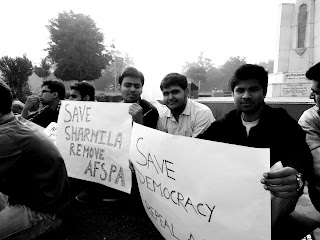 A few weeks ago when I was mid-breakdown, stressing about people and work, my host-sister gave me some words of wisdom. She said there's no need to worry about relationships... our lives are like passenger trains; we are going along on our track of life, we make stops, people come on and off, some staying on just for a few stops while others are on for the whole trip.
A few weeks ago when I was mid-breakdown, stressing about people and work, my host-sister gave me some words of wisdom. She said there's no need to worry about relationships... our lives are like passenger trains; we are going along on our track of life, we make stops, people come on and off, some staying on just for a few stops while others are on for the whole trip.A nice sentiment, but I might take it a little further. It's more like our lives are crazy trips in India-- passenger trains for sure, but you can't forget the share-jeeps, the rickshaws, sleeper buses, and tiny airplanes. Our lives are more like the trip Sophia and I experienced from Darjeeling, trying to get back to Delhi for our flight home. After our flight from Bagdogra in West Bengal to Delhi was cancelled due to fog, we decided we would have a better chance of flying out of Calcutta with the weather to catch our flight back to America (which was scheduled for the next night). So we hopped on a bus to Calcutta-- don't worry, it should only take about 12 hours to get there... 15 hours max. You will definitely be able to catch your flight at 2 pm tomorrow.
False. 22 hours later, and a terrible bout of food poisoning that had me vomiting on the side of the road all night while the conductor just said "impossible" when I told him we had to make our flight home, we stumbled into the airport in Calcutta. Missed our flight by 5 hours. After hassling every airline agent, we got the last flight available to Delhi that night, still missing our flight to America by about 2 hours.
So basically, after every type of transportation, hours of weeping on the phone, weeping on the bus, weeping at the counter at the airport, flights were rescheduled and I am now sitting at the Cleveland airport, drinking a coffee that is absolutely absurd (in what world is this a medium sized coffee??? Oh right...). And the people who stuck with me on that journey, the people who refilled rupees on my phone, called the travel agents, and gave me moral support when I was ready to die on that God-forsaken bus, those people are on my passenger train for good.
 In case you are feeling sorry for me, don't worry-- I thoroughly enjoyed myself stuffing my face with momos and drinking endless tea in Darjeeling.
In case you are feeling sorry for me, don't worry-- I thoroughly enjoyed myself stuffing my face with momos and drinking endless tea in Darjeeling. |
| There is no way this could cause food poisoning... too delicious |

























